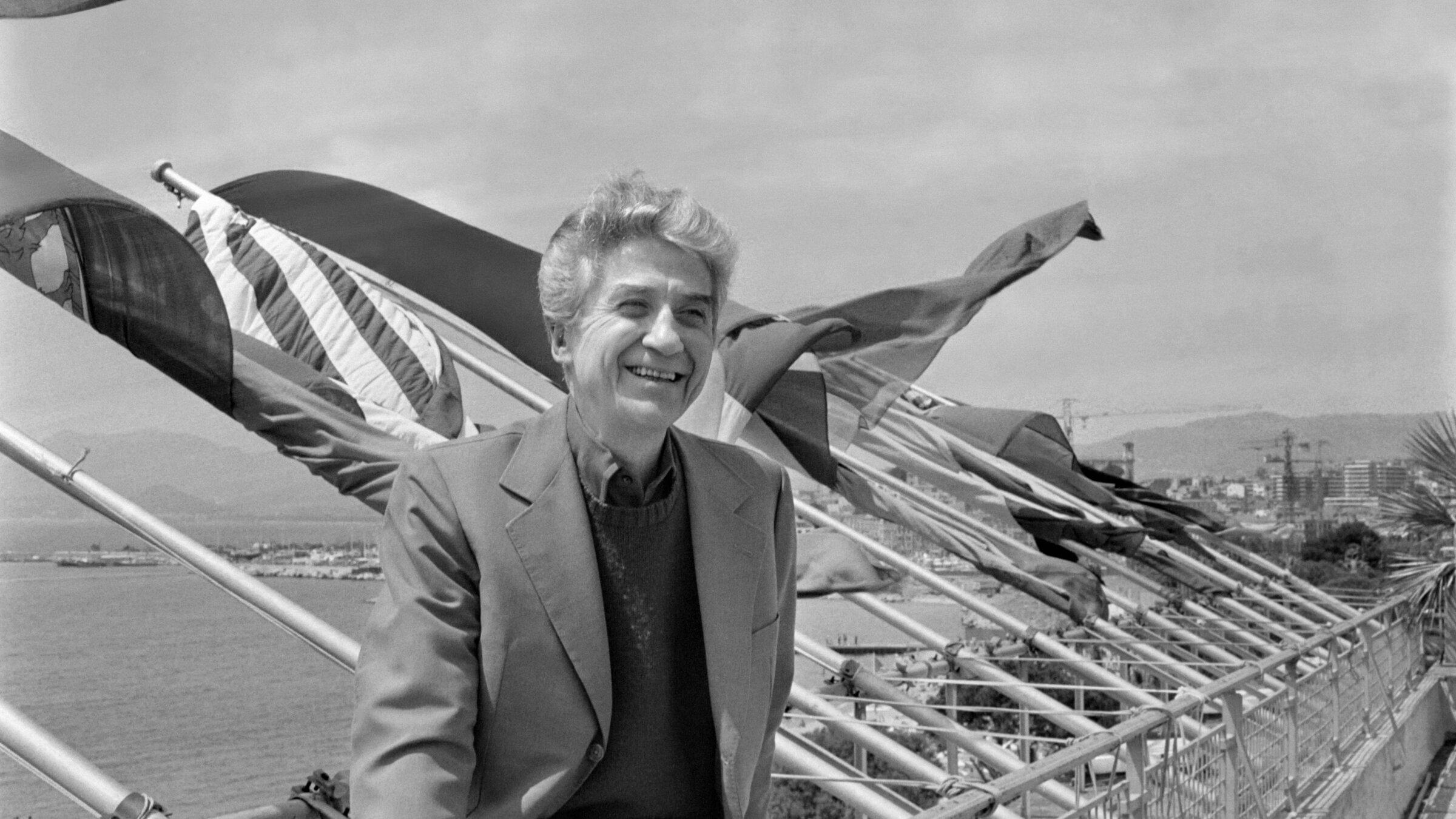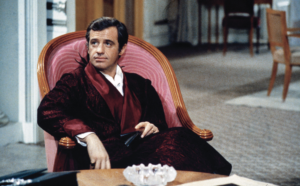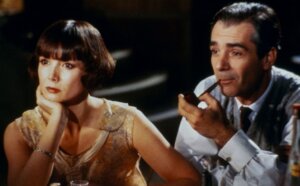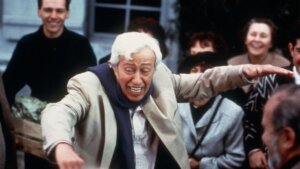The Jewish ‘songs’ of Alain Resnais
A retrospective for the filmmaker’s 100th birthday finds a mixed, but compelling, bag of Jewish content

Alain Resnais at Cannes in 1980. Photo by RALPH GATTI/AFP via Getty Images
When it comes to Alain Resnais’ eclectic, innovative and at times uneven filmography, it is the critic’s task to decipher common themes. Resnais simply saw it as his mission to direct.
At least early on, the Left Bank director gave a false impression of his ultimate trajectory. He was intensely political — until he wasn’t so much. While sometimes classed with the French New Wave, he didn’t neatly fit the model of the Cahiers du Cinema’s auteur theory. He was almost always challenging, but, often, the challenge was pondering why Resnais picked particular projects, leaping from meditations on human tragedy to psychological sci-fi to a surprising number of adaptations of the British playwright Alan Ayckbourn. He even did a musical!
It makes more sense when you know that both his breakout films, 1955’s Holocaust documentary “Night and Fog,” and its feature film follow-up, 1959’s “Hiroshima Mon Amour,” were commissions – though ones he reimagined to immortal effect by enlisting talented collaborators. For casual film fans, these early works are what Resnais is remembered for. But they were never really what he was about.
Resnais followed “Hiroshima” with “Last Year at Marienbad,” a narratively inventive take of fleeting human connection. From there on, and with rare exception, Resnais called his own shots, following his interests in art music and theater and the regular stable of creatives he relied upon for screenplays and inspiration. He rejected the title of auteur, and, one suspects, found liberation in the rejection. If some of his films are inconsistent, or fail to cohere as a unified corpus, it’s clear Resnais, whose swan song feature was completed just before his death at 91, had fun making them.
But now that Resnais, who would turn 100 this year, is receiving a 21-film retrospective at Film Forum, we might consider the sweep of his oeuvre with a more particular lens. For a memorable handful of the films, we can understand Resnais best by how he followed his muse — or, rather, his Jews.
‘Night and Fog’
“Night and Fog,” while controversially lacking in discussion of the Final Solution, set the standard for how the Holocaust could be represented in film. It was also the apotheosis of Resnais’ technique of montage. François Truffaut called it “the most notable and necessary film ever made.”
In just over 30 minutes, Resnais achieved a kind of guiding ethos.
“I came to see that all you could do was suggest the horror — that if you tried to show something very real on the screen, the horror disappeared — so I had to use every means possible to set the viewer’s imagination in motion,” Resnais said in an interview.
Resnais, then 32, had already made a few short films: a documentary about van Gogh, a study of Picasso’s “Guernica” and a corporate film about plastic manufacturing (“The Song of Styrene”). What he made with “Night and Fog,” using propulsive tracking shots, and alternating between black-and-white archival footage and color images of the contemporary countryside at Auschwitz and Majdanek, is the world’s most horrific industrial film. In an affectless narration, soon to be a trademark of much of Resnais’ work, we learn about the Nazi apparatus and murder machine, blurring by its stations at a breakneck speed to Hanns Eisler’s score.
When Resnais was given the project, it was imagined as a companion piece to a 1954 exhibition honoring resistance fighters. Feeling his experience unequal to the subject, he only agreed to undertake the film if Jean Cayrol, a resistance fighter, poet and survivor of the camps, would write and narrate the text. Of enormous consequence to the film’s overall thrust, Resnais largely ignored the charge to include artifacts from the exhibition. This was not about something so narrow as one country. It was about how the unthinkable came to pass with a sadistic, mechanical ease.

Conditions of the cattle cars — “hunger, thirst, suffocation, madness” — are recited like features of an assembly line. We’re told, of Mauthausen, where Cayrol was interned for two years, how “3,000 Spaniards died” building steps that appear on screen. SS maxims are conveyed like the banal platitudes of industrial efficiency. We see what’s involved in this industry of death. The hierarchy of inmates, capos, guards. The different badges of prisoners. The byproducts of prisoner processing: a 30-second climbing shot of an endless mountain of human hair, sold as cloth at “15 pfennig a kilo.”
Of course there are also the bodies, the walking skeletons, the decapitated corpses and the final image of a demolished crematorium, left to collect moss, threatening to become a memory. “We pretend to regain hope as the image recedes, as though we’ve been cured of that plague,” Cayrol says. “We tell ourselves it was all confined to one country, one point in time.”
The narration of “Night and Fog” says the word “Jewish” only once, in reference to a Dutch student, one of many victims. To fault the film for that is ungenerous. We see the yellow stars, the endless ledger of Jewish names and their numbers. And knowing the film was originally conceived, with no small amount of nationalist indignation, to highlight the suffering of the French, its universal approach is to be welcomed.
There is a caveat: Resnais, up against the censor, was ordered to remove an image of a French policeman guarding Jews at a deportation camp. Given the choice to change the photo or lose the last 10 minutes of the film, which show the full force of a genocide of millions, Resnais painted a beam in to cover the gendarme’s telltale kepi, a French-style military hat. The original image is restored in the version running at Film Forum, complicating the original narrative of Resnais’ patrons with a proof of French complicity.
The production story of “Night and Fog” is largely one of defiance and, though it was not a subject of his choosing, the film’s preoccupation with human cruelty, and its filmmaking techniques, remained with him.
‘Stavisky’
When Resnais first truly engaged with the Jewish question in 1974’s “Stavisky,” he understood the assignment. Working off a script from Resnais collaborator Jorge Semprún, a screenwriter, Spanish Republican and later minister of culture for Spain, the film marked a new frontier for Resnais.
Jean-Paul Belmondo approached Semprún to write a screenplay based on Serge Alexandre Stavisky, a Ukrainian-born Jewish conman who, in a second life as a theater owner with connections to France’s political elite, upended the ruling liberal party in a false bond operation.
Resnais wanted to helm the project. Belmondo was the biggest on-screen talent Resnais had yet lensed, and he chose to film this Art Deco period piece using only techniques possible in the 1930s. He and Semprún also took care to emphasize a key factor of the Stavisky Affair: the xenophobia and antisemitism that foreshadowed Vichy.
Again, Resnais’ montage tells the story – in his words, an almost impressionistic “song about Stavisky.”
The lush music of Stephen Sondheim — a rare film score — shows Stavisky glide down a luxe hotel elevator, intercut with the journey of another Eastern European Jew and scapegoat: Leon Trotsky, traveling to his exile in France with no accompaniment, save the sounds of nature and his luggage-stacked motorcar.
Indeed, each time we leave Stavisky’s extravagant life to spy on Trotsky’s wandering Jew subplot, the music stops, signaling something amiss, a comfort or pageantry lost. By the end of the film, the conservative government that rose with Stavisky’s fall forces Trotsky out of the country right, as one character says, “when France must fight against fascism.”
Resnais and Semprún’s choice to focus on these two figures of history — one an opportunistic arch capitalist, the other a principled figurehead and of Marxism — makes for a revealing set of foils for what they have in common. Trotsky, whom we never hear speak, and whose face we seldom see, is a bellwether for a Jew’s tenability in Europe. Both Stavisky and Trotsky had access to levers of power — until a regime change emphasized their otherness. Both men’s stories speak to the provisional safety and tenuous status of a Jew.
The point is made most trenchantly in the figure of a minor, fictional character linking the two: a German-Jewish actress named Erna Wolfgang. In an audition at Stavisky’s theater, she explains her plight.
“Since the Nazis took power this year it’s hard for us to live in Germany,” Erna says. “It has never been easy for us to live anywhere.”
In less sensitive hands, a viewer might take away the pessimistic or even antisemitic view that Jews can’t continue to live in the diaspora. But there can be no mistaking that Erna, a German actress fluent in French; Stavisky, a continental who operates a theater; or Trotsky, who, ousted by Stalin, hosts salons from exile with a who’s who of intellectuals, are anything but creatures of European society. They have not failed at assimilation. They have succeeded so thoroughly that their own countries rebuke them, making every improbable attempt to cast them as outsiders.

Also threaded throughout “Stavisky” is the question of what it means to announce one’s Jewishness, and the perils of that decision. It comes in the form of a news report about a titan of industry returning to Judaism to protest Nazi persecution. And it’s seen in a memorable exchange between Stavisky (now going by “Serge Alexandre”) and Erna.
Responding to his question about her choice to “broadcast” that she’s Jewish, she tells Stavisky, “I hate races that don’t know themselves. Jews who think they’re happy, have equal rights and are ‘safe.’”
The words are prescient, and a paraphrase of her audition scene earlier in the film. For it, she read from Jean Giraudoux’s play “Intermezzo,” in which a specter, believing itself to be mortal, is likened to “Indians who think they are red” and “Negroes who think they are white.”
Stavisky reads the role of “Specter” opposite Erna. After he dies, it’s in that role that Stavisky’s friend remembers him, calling him a “herald of death. Not only his own … but the end of an era.”
It was an era where a Jew like Stavisky could thrive and Jews like Trotsky and an innocent Jewish actress could seek safe harbor in France. The film’s final images — a moss-covered mausoleum that calls to mind the broken crematorium of “Night and Fog” and the gates of Petite-Roquet prison, where women political prisoners were kept during World War II — give us a glimpse of what would follow.
‘Mélo’
In 1986, Resnais made “Mélo,” an adaptation of Henri Bernstein’s 1929 play of the same name. Its story is hardly a Jewish one, but the production of the original drama suggests something of the topic of “Stavisky.”
Bernstein was a victim of French fascism as early as 1911, when Action Française protested his 1911 play “After Me,” owing to the author’s heritage and his desertion of military service. Bernstein spent World War II in luxurious exile at New York’s Waldorf-Astoria, even as he composed screeds against France’s collaborationist government, and his earlier plays often broached themes of Jewish assimilation and French antisemitism.
“Mélo,” on the other hand, is a kind of insipid prototype of Pinter’s “Betrayal.” Not bad by any means, but by no means groundbreaking.
Resnais was not the first to adapt “Mélo” to film – that was Paul Czinner, in 1932. Czinner was Jewish and fled Germany for England, where he remade “Mélo” as “Dreaming Lips” in 1937. So, Resnais’ predecessors were both Jews in exile.

Resnais’ take on “Mélo” unwinds like a filmed play, with little of his trademark montage, a lot of long takes and a mise-en-scene better suited to a stage than a film set. Most remarkable is his choice, in a melodrama about musicians, not to feature any non-diegetic music, or music that doesn’t occur naturally in the scene. The plot is a bit of musty “well-made play,” involving violinist friends, the more successful of whom begins an affair with the other’s wife (played by Resnais’ real-life wife Sabine Azéma). Resnais elevates it nonetheless.
Resnais’ commitment to stagecraft here, which he’d pick up in later play adaptations, feels like a deliberate artistic choice to forego his usual modus operandi of narrative experimentation, creative use of score and clever editing. That’s not to say he was done with his old tricks.
‘I Want to Go Home’
We may never fully understand why Resnais committed to film an orgiastic masquerade wherein Gérard Depardieu dresses like Popeye, Linda Lavin (with a fake Olive Oyl nose) has a serious discussion with her boyfriend’s daughter (Laura Benson, made up like Tweety Bird), and a puffed-up French intellectual claims, “It’s obvious to everyone that Woody Allen is greater than Bergman.”
As ever, the film, “I Want to Go Home,” makes more sense when we look at who Resnais was excited to work with and the things he naturally gravitated to. Resnais wanted to collaborate with Pulitzer-winning cartoonist and writer Jules Feiffer, who wrote the script — and who, not incidentally, penned the Robert Altman “Popeye” a few years before. And Resnais wanted to pay tribute to his own love of comics and see how that medium could work with his own.
Out came this film, about washed-up comic artist Joey Wellman (legendary lyricist Adolph Green) in Paris to attend a Bande Dessinier (comic book) convention. Wellman is a typical annoying American — the film is titled for his obstreperous objections to France — and his alienation and discomfort are only exacerbated by a congenital condition called Jewishness. This, in all its strange glory, with a score by Jewish musical theater mainstay John Kander, is perhaps the most Jewish film Resnais ever made — and also the furthest from sticking the landing. It failed to even land a distribution deal in the U.S. and U.K., despite being mostly in English. Those who grouse about the steely detachment of Resnais dramas may make a better case by observing this farce.

Just as Wellman fails to understand France, Resnais seems hard-pressed to capture Feiffer’s nutty script. Rather than shooting it like a comic book, he instead brings his elevated style to bear on the material as Wellman is invited to the French countryside. The aforementioned cartoon masquerade toys with the tension of mannered country estate films with their secret rooms and trysts and the fanciful costumes of E.C. Segar.
But the contrast of high and low, American and French, so baked into the screenplay just doesn’t work. And one wonders if it isn’t, in fact, already something of a fait accompli.
Woody Allen, sent up twice — once in comparison to Bergman and the first time vis a vis the “Annie Hall” director’s stance on a Palestinian state (and whether Wellman, “as a fellow Jew” agrees with it) — had by then merged the ethos of neurotic city Jew and European arthouse. But having an actual European director handle this work of Yid Abroad feels trite and disjointed if not altogether lost in translation.
The meta satire in the plot, in which a brutish American director (John Ashton), dressed like a caveman, says he makes violent movies because that’s all Americans have left to say in film — unlike the French — feels imprecise. This guy’s clearly a buffoon, but it’s weird for Resnais to film this claim, regardless of his thoughts on its validity.
It’s equally strange when the sentiment is swapped. When Depardieu’s Flaubert professor, Christian, in hardly discernible English, first meets Wellman, he praises his cartoons’ “American immigrant” innocence (though one senses he’s no new arrival to the U.S.). He also moons over the optimism of “the ones who made Hollywood.”
The delivery, like much of the film’s comedic timing, is so clumsy that this clear Jewish innuendo is missed. It almost feels like a reference that, while meaning something quite concrete to Feiffer, meant something completely different to Resnais or Depardieu or the character saying it.
But for our purposes, this moment plays as a kind of commentary on Resnais’ appreciation for and understanding of Jews. He might be called a philosemite, sensitive to Jews’ concerns and influenced by their creativity. But in each instance where Resnais engaged with a Jewish subject, he was at his most adept when the frame of reference was French, like he was. For that reason the line that lands best in “I Want to Go Home,” is as follows.
From an offscreen room, we hear people debating U.S. presidents, with one man dismissing Roosevelt for doing “nothing for the European Jews.” An arch retort, from an unmistakably French voice, answers “in France we can understand that.”
If anyone deserved to deliver that punchline, it was Resnais.
“Alain Resnais 100” is now playing at Film Forum. Information and tickets can be found here.
















